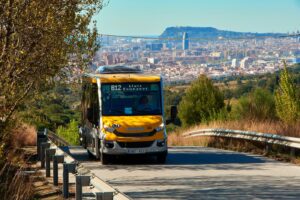
Launch of the satellite SOAR, as part of the Discoverer project, led in Spain by the UPC
June 15, 2021
Telerehabilitation for people who have suffered a stroke and have chronic injuries
June 18, 2021The Wireless Networks Group (WNG) is leading WINTERTIME, a project to design and implement a wireless mesh for the internet of things (IoT) with low-power radios.
The Internet of Things (IoT) allows the integration of all kinds of objects into common telecommunications networks, facilitating interaction between users and "things" in everyday environments through applications for home, the city, transport or the intelligent industry, among many others. IoT devices generally have a wireless communication interface, but due to their very low consumption and low cost requirements, the technologies commonly used for personal communications (e.g. Wi-Fi or LTE) are not suitable. The main idea of the project is to integrate users and "things" in the same network, despite the fact that they use incompatible communication technologies.

In a Wake Up Radio (WuR) system, there is a primary radio for high capacity and low latency communications, having also high energy needs, which is why it is desirable to keep it in an energy saving state as long as possible. While the primary radio is off, a low-power secondary radio remains active. This secondary radio or wake-up radio is responsible for "waking up" the primary radio upon request.
This project is proposed as an extension of the ALLINONE project, which was also developed by WNG. In ALLINONE, WuR mechanisms are developed and tested with the potential to be used to communicate devices with non-compatible primary radios. With this approach, in addition to the application focused on energy savings, the possibility of having an additional low-cost and low-power radio in any electronic device opens the doors to a large number of new applications. These new applications are the focus of the project, which aims to design, analyze and develop different applications of a low power radio system within the framework of a wireless mesh network. This architecture could facilitate the integration of IoT in 5G (case of mass communications between machines), being also useful in vehicular communications scenarios or even in satellite networks.
The project was funded by the Spanish State Research Agency with an allocation of 163,350 euros. The project started in 2020 and will finish in 2024.
You want to know more?
Related Projects
- The BIOsignal Analysis for Rehabilitation and Therapy (BIOART) research group at the Universitat Politècnica de Catalunya – BarcelonaTech (UPC) coordinates the Proactive Response and Efficient Planning with AI for Resilient Emergencies in hospitals (PREPARE) project, which aims to optimise hospital preparedness during emergencies through dynamic capacity and risk assessment using artificial intelligence (AI).
- A research team from the inLab FIB at the Universitat Politècnica de Catalunya - BarcelonaTech (UPC), together with the Asociación de Personas con Movilidad Reducida (AsoPMR), has taken part in the Spot4Dis project to enhance the mobility and autonomy of people with reduced mobility.
- The Barcelona Innovative Transportation (BIT), the Research Center in Automotive and Advanced Mobility (CER-AMA) and The Future Mobility Research Hub (CARNET) research groups from the Universitat Politècnica de Catalunya - BarcelonaTech (UPC) are participating in the E-MED project, which aims to optimise energy and resource efficiency in public transport systems by addressing energy price fluctuations through smart and participatory solutions across the Mediterranean region.
- The company Friselva S.A., Corporació Alimentària Guissona (bonÀrea), together with the Food Service Cluster and inLab FIB at the Universitat Politècnica de Catalunya - BarcelonaTech (UPC), are participating in the Hydroless project, which aims to optimise water consumption in meat production plants. The project includes an innovative solution to monitor and optimise water use at bonÀrea’s plant in Guissona, as well as the design and development of a digital twin of Friselva’s facilities in Riudellots de la Selva.




